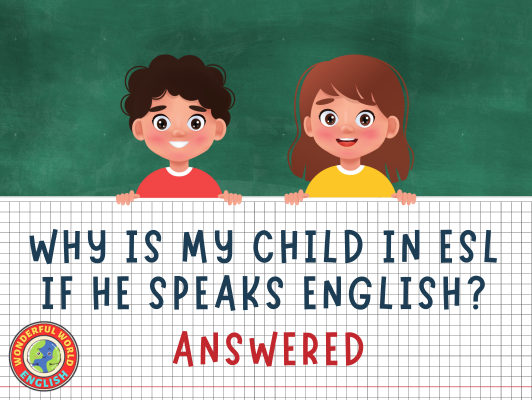Contents
Toggle
Meet David De’ Ath, founder, editor, and writer at Wonderful World English. With his extensive background as an English teacher, David provides valuable insights and practical tips on ESL for students and teachers alike.
Many parents wonder why their child is placed in an ESL (English as a Second Language) program when they already speak English.
The placement often stems from comprehensive language assessments that schools conduct to ensure each child receives the appropriate level of support in language development.
While a child may comfortably converse in English, the school aims to strengthen other facets of language proficiency, including reading, writing, and comprehension.
Schools are mandated to perform an initial evaluation of students’ language abilities if their Home Language Survey indicates a language other than English is spoken at home.
This is not a reflection on the child’s capabilities but rather a standardized step to identify students who might benefit from additional language support.
The goal is to help students fully engage with the curriculum and their peers, and alleviate any potential academic challenges associated with language barriers.
Some children may be fluently bilingual yet find themselves in an ESL program due to nuances in state or district regulations concerning language learning and proficiency benchmarks.
Parents need to communicate with educators to understand the specific reasons for ESL placement and to collaboratively monitor the child’s progress, ensuring the support provided aligns with the child’s academic needs and language proficiency.

Understanding ESL Placement
In public education systems, students are often evaluated to determine the need for supplemental English language support.
This process ensures that all learners have the chances to excel academically, regardless of their English proficiency at the outset.
Assessment Processes
Home Language Survey: Upon enrollment, parents typically complete a Home Language Survey for their child.
This initial step is crucial, as it identifies children who may speak a language other than English at home.
- English Language Proficiency Evaluation: If the survey indicates another language is used at home, schools will typically administer an assessment to gauge the child’s English proficiency level. This evaluation comprises several components:
- Listening
- Speaking
- Reading
- Writing
Based on the results of these evaluations, a child may be designated as an English Language Learner (ELL) and recommended for placement in an ESL program.
This classification is not necessarily a reflection on the child’s ability to communicate casually in English but rather on their proficiency in academic English, which is critical for success in school.
Benefits of ESL Programs
- Tailored Educational Support: ESL programs are designed to provide targeted instruction that helps ELLs develop academic English skills. These programs often employ strategies that cater to various proficiency levels.
- Cultural Competency: ESL educators are trained to be culturally responsive, which can help ease the integration of ESL students into the school environment.
Resources and Assistance:
- Certified ESL Teachers: ELLs receive support from teachers with specialized training in teaching English to non-native speakers.
- Parental Involvement: Schools encourage parent participation in their child’s language learning journey.
ESL programs interweave the development of English skills with the main curriculum, allowing children to continue learning other subjects while improving their language abilities.
This dual-focus approach benefits students by minimizing the lag in content knowledge while enhancing English proficiency.

Supporting English Language Development
The development of English skills in children, especially in the context of an ESL program, not only requires dedicated instruction but also hinges on parental involvement and the use of strategic approaches both in and out of the classroom.
Parental Involvement and Support
Parents play a critical role in a child’s language development.
They offer essential exposure to English outside the classroom and can provide encouragement that fuels the child’s interest and motivation.
Parental engagement in a child’s academic life has been shown to positively influence their English proficiency and overall academic performance.
It is also important for parents to work with ESL teachers to align strategies that support the child’s learning requirements.
Parents should encourage reading and the use of English at home, fostering an environment where children can practice vocabulary and other language skills in a supportive setting.
- Encouragement in the Native Language: Parents should continue to develop their child’s native language alongside English, as this can strengthen cognitive abilities and linguistic understanding, which are transferable to learning English.
- Collaboration with Educators: Parents should actively collaborate with educators to stay informed about their child’s progress and the ESL program’s methodologies that align with state standards for English learners (ELs).
Strategies for Success in and out of ESL
The pathway to English proficiency involves a range of strategies that address various aspects of language learning, from direct instruction in reading and writing to the integration of academic language across all academic content.
- Visual and Hands-on Learning: Incorporating visuals and manipulatives helps EL students make connections between words and their meanings, thus aiding vocabulary acquisition and improving comprehension of academic content.
- Direct Instruction: Focused direct instruction on academic English, especially tailored to meet the ESL program criteria and state standards, can accelerate the development of oral and academic language proficiency.
Reading Strategies:
- Activities like pointing to corresponding pictures while reading or acting out stories can engage EL students more actively and help them learn the left-to-right flow of English text.
Academic Support:
- To assess and differentiate between a language barrier and a possible learning disability, special education services may be necessary. It ensures that each child receives targeted support appropriate to their unique learning needs.
By employing these specific strategies, ESL programs and parents can together create opportunities that significantly enhance a child’s ability to learn English and succeed academically.
For some insights on how to improve the reading abilities of a child, the guide below has you covered!
Related: How to Improve Reading Skills of a Child – Teacher’s Tips

Conclusion
The journey of language development in children, particularly those participating in ESL programs, involves comprehensive strategies encompassing both educational environments and home settings.
These approaches aim to bolster conversational fluency in English and the critical academic aspects of reading, writing, and comprehension.
Schools initiate this process with an evaluation of a child’s language abilities, informed by a Home Language Survey.
This step is crucial for identifying students who may benefit from additional language support, ensuring they can fully participate in their education.
Even fluently bilingual children might find themselves in ESL programs due to the specific requirements of language proficiency standards.
Parents need to engage in open dialogues with educators to understand and support their child’s language learning journey.
ESL programs are meticulously designed to cater to the unique needs of English Language Learners (ELLs), offering a curriculum that simultaneously advances English proficiency and academic knowledge.
Teachers specialized in ESL employ diverse and culturally responsive teaching methods, fostering an inclusive learning environment that respects and values the linguistic backgrounds of all students.
Parental involvement is paramount in this educational endeavor.
Parents are encouraged to foster an environment that supports English language use at home while also preserving the child’s native language, which can enrich their cognitive and linguistic development.
Collaborating with teachers and parents can align educational strategies, ensuring the child receives a consistent and supportive learning experience.
The essence of ESL programs lies in their ability to integrate language development with academic learning, providing students with the necessary tools to excel both linguistically and academically.
Through targeted instruction, strategic learning approaches, and the active participation of parents, ESL programs endeavor to equip students with the confidence and skills needed to navigate their educational pathways successfully.
We hope you find value in this information; you can reach out to us if you require any assistance or support.
Have a wonderful day!
Image Attribution: All images licensed via canva.com





